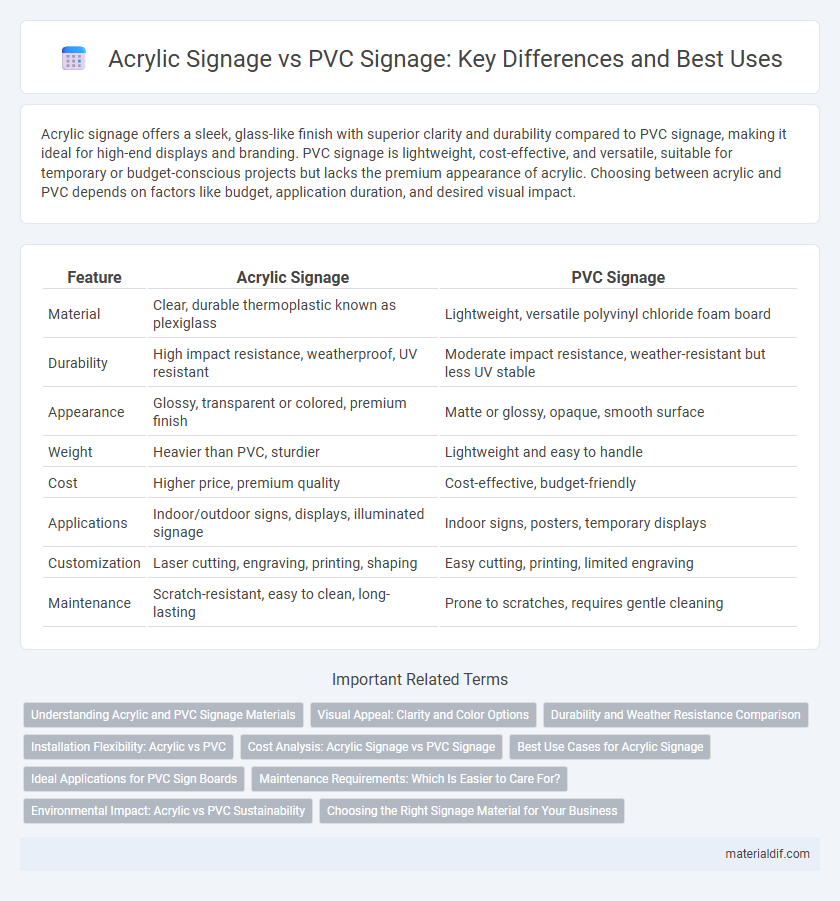Acrylic signage offers a sleek, glass-like finish with superior clarity and durability compared to PVC signage, making it ideal for high-end displays and branding. PVC signage is lightweight, cost-effective, and versatile, suitable for temporary or budget-conscious projects but lacks the premium appearance of acrylic. Choosing between acrylic and PVC depends on factors like budget, application duration, and desired visual impact.
Table of Comparison
| Feature | Acrylic Signage | PVC Signage |
|---|---|---|
| Material | Clear, durable thermoplastic known as plexiglass | Lightweight, versatile polyvinyl chloride foam board |
| Durability | High impact resistance, weatherproof, UV resistant | Moderate impact resistance, weather-resistant but less UV stable |
| Appearance | Glossy, transparent or colored, premium finish | Matte or glossy, opaque, smooth surface |
| Weight | Heavier than PVC, sturdier | Lightweight and easy to handle |
| Cost | Higher price, premium quality | Cost-effective, budget-friendly |
| Applications | Indoor/outdoor signs, displays, illuminated signage | Indoor signs, posters, temporary displays |
| Customization | Laser cutting, engraving, printing, shaping | Easy cutting, printing, limited engraving |
| Maintenance | Scratch-resistant, easy to clean, long-lasting | Prone to scratches, requires gentle cleaning |
Understanding Acrylic and PVC Signage Materials
Acrylic signage provides a glossy, high-impact aesthetic with superior clarity and durability, making it ideal for vibrant, long-lasting displays. PVC signage, composed of lightweight and cost-effective linear polyvinyl chloride, offers versatility and resistance to moisture, suitable for indoor and outdoor use where budget constraints exist. Understanding the distinct material properties highlights acrylic's premium visual appeal versus PVC's practical flexibility in various signage applications.
Visual Appeal: Clarity and Color Options
Acrylic signage offers superior visual appeal with its high clarity and glossy finish that enhances colors and sharpness, making graphics more vibrant and eye-catching. In contrast, PVC signage tends to have a matte or less transparent surface, resulting in muted colors and diminished visual depth. Acrylic's ability to maintain brightness and color fidelity makes it the preferred choice for premium signage applications requiring impactful, vivid displays.
Durability and Weather Resistance Comparison
Acrylic signage offers superior weather resistance and durability compared to PVC signage, maintaining clarity and structural integrity in harsh sunlight and moisture-prone environments. Unlike PVC, which can become brittle and fade over time when exposed to UV rays and fluctuating temperatures, acrylic retains its color vibrancy and impact resistance for longer periods. This makes acrylic an ideal choice for outdoor signage requiring long-lasting visual appeal and strength.
Installation Flexibility: Acrylic vs PVC
Acrylic signage offers superior installation flexibility due to its lightweight nature and ability to be easily cut into complex shapes without compromising structural integrity. PVC signage, while durable and cost-effective, is generally heavier and less adaptable to intricate designs, limiting mounting options. Acrylic's smooth surface and clarity also allow for versatile applications in both indoor and outdoor settings, enhancing installation possibilities compared to PVC.
Cost Analysis: Acrylic Signage vs PVC Signage
Acrylic signage typically incurs higher initial costs due to its premium material quality and polished finish, offering enhanced durability and aesthetic appeal compared to PVC signage. PVC signage is more budget-friendly and cost-effective for large-scale or temporary installations, though it may require more frequent replacements due to lower resistance to weather and wear. Evaluating cost-effectiveness depends on the signage's intended lifespan, environmental exposure, and design complexity, where acrylic provides long-term value, while PVC suits short-term, economical needs.
Best Use Cases for Acrylic Signage
Acrylic signage excels in environments requiring high clarity, durability, and a premium aesthetic, making it ideal for indoor displays, retail branding, and corporate office signs. Its resistance to UV light and weathering allows for semi-outdoor applications like entrance signs and illuminated displays. Compared to PVC signage, acrylic offers superior gloss and color vibrancy, enhancing visibility and brand impact where visual appeal is paramount.
Ideal Applications for PVC Sign Boards
PVC sign boards excel in outdoor advertising due to their durability and resistance to weather, making them ideal for long-lasting promotional signs. They are commonly used for retail storefronts, construction site signage, and directional signs where impact resistance and lightweight properties are essential. PVC's moisture resistance also suits indoor environments with high humidity, such as swimming pools or bathrooms.
Maintenance Requirements: Which Is Easier to Care For?
Acrylic signage requires minimal maintenance due to its resistance to moisture, fading, and cracking, making it easy to clean with just mild soap and water. PVC signage is also durable and weather-resistant but may require more frequent cleaning to prevent discoloration and surface wear. Overall, acrylic signage offers a lower maintenance commitment, ideal for long-term outdoor and indoor use.
Environmental Impact: Acrylic vs PVC Sustainability
Acrylic signage offers better environmental sustainability compared to PVC signage due to its longer lifespan and recyclability, reducing the frequency of replacements and waste. PVC signage contributes significantly to environmental pollution because it is less biodegradable and releases harmful chemicals during production and disposal. Choosing acrylic supports eco-friendly practices by minimizing toxic emissions and promoting material recovery in signage applications.
Choosing the Right Signage Material for Your Business
Acrylic signage offers superior clarity, weather resistance, and a polished, high-end look compared to PVC signage, which is more cost-effective and lightweight but less durable. For businesses seeking vibrant, long-lasting displays, acrylic's UV resistance and sleek finish make it ideal for outdoor and premium branding applications. PVC is suitable for budget-friendly, temporary, or indoor signs where affordability and ease of installation are priorities.
Acrylic Signage vs PVC Signage Infographic

 materialdif.com
materialdif.com